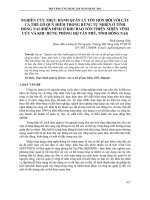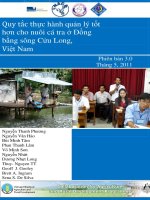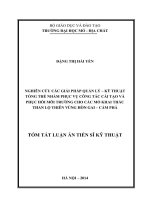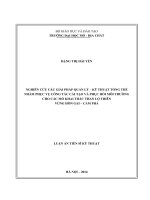Thực hành quản lý tốt hơn cho nền văn hóa cá mú ở Indonesia
Bạn đang xem bản rút gọn của tài liệu. Xem và tải ngay bản đầy đủ của tài liệu tại đây (3.66 MB, 26 trang )
PRACTICAL MANUAL
BETTER MANAGEMENT PRACTICES
for Grouper Culture in Indonesia
Prepared By:
Reza Shah Pahlevi
Abdullah
N. Kurnia
2
CONTENT
A. KEY ASPECTS FOR SUCCESSFUL GROUPER FARMING
B. FARMER GROUP FORMATION
C. CAGE CROP PLANNING
D. CROP CALENDAR
E. BETTER MANAGEMENT PRACTICES FOR CAGE CULTURE
I. Site of cages
II. Design and construction of cages
III. Cage preparation practices
IV. Grouper seed selection and stocking practices
V. Feed management practices
VI. Water management practices
VII. Health management practices
VIII. Harvest and post-harvest handling practices
IX. Keeping cage culture daily record book
X. Improve marketing practices
XI. Capital Strengthening
3
A. KEY ASPECTS FOR SUCCESSFUL GROUPER FARMING.
1. Availability of adequate quality of fish seed.
2. Maintain local environment in site the cage as well as around the cage.
3. Fresh feed and efficient feeding strategy.
4. Regular monitoring water quality.
5. Applied substitution from trash fish to pellet.
6. Pests and disease control
7. Follow crop calendar system for grouper farming
8. Implement all grouper culture activities in a disciplined and cooperative manner
9. Apply size segregation to avoid cannibalism and slow growth
10. Periodical maintenance of netcages to reduce risk on disease outbreak, to
increase water circuration and nutrient supply and to reduce pollutant.
11. Organize farmers group to bargain for better price from the buyer.
12. Produce high quality product to have good market base.
13. Establish information centre where farmers can seek information on better
technology, market, credit, production inputs and find problem solution.
14. Availabilty of accessible credit.
15. Empowering woman to participate in fish feeding preparation and worker’s food
suplly.
4
B. FARMER GROUP FORMATION.
1. Fish farmer group should be formed at village level for self help and cooperation
among local farmers.
2. A farmer group should ideally consist of about 10-30 farmers.
3. Farmer ideally should have about maksimum of 20 units devide into 4
compartments spreading in one location and sharing the same water sources.
4. Farmer group should meet at least once a month at a fixed time in fixed place to
discus the crop atctivities problems and solutions.
5. Unity in farmers through farmer group formation reduces risk in the crop and
increases the success of the crop.
6. It gives better bargaining power to farmers for input purchases and product
sales in the market thus increasing their profit.
7. Diferent business scale of farmer group within the district should be assembled
in UPP (Development and Service Unit).
8. If necessary, involve woman as secretary or treasurer of fish farmer group.
5
C. CAGE CROP PLANNING.
1. Attemp only one crop in a year or one crop in one and half year.
2. Attemp gradual stocking of seed for continuos harvest.
3. Attemp to put the cages near the shore during monsoon season to avoid damaging
the cage.
4. Plan the crop within financial capacity of individual farmer 25 million rupiah (three
thousand us dollars).
5. Plan the cage culture based time suitability and management skills of farmers.
6. Base on the farmers local experience, understand the local environmental capacity
considering effluent from shrimp pond and domestic waste and plan the crop
accordingly.
7. Use the crop calendar system.
6
D. CROP CALENDER.
7
E. BETTER MANAGEMENT PRACTICES FOR CAGE CULTURE
I. Sellect the site of the floating cage according to district spatial planning and
environmentally appropriate location such as away from navigation line,
protected from big wave and unpolluted water.
II. Design and construct of floating cage should be strong to minimize risk of
damage.
III. Cage preparation practices
a. Clean the net from debris or waste through spraying or deeping in
recommended disinfectan.
b. Dry in sun light in clean location.
c. Repair any damage found in the cage unit including mooring system and
buoyancy as well cage frame.
d. Set up the cage properly in suitable site.
IV. Grouper seed selection and stocking practices.
a. Ensure seed coming from wild and hatchery in good quality such as health
and have relatively uniform size to avoid canibalism.
b. Ensure the hatchery unit producing the seed has been certified or provided
with health confirmation from the local aquaculture centre.
c. Ensure proper acclimatization is properly implemented.
8
d. Ensure stocking is conducted during ambient temperature normally in the
early morning or late afternoon.
e. Avoid seed stocking during heavy rain.
V. Feed management practices
a. Source of feed is from trash fish and pellet feed. Trash fish should be in
fresh condition. Commercial Pellet fish should be registered in Directorate
General of Aquaculture, mean while home industry pellet should meet meet
Indonesia National Standard.
b. Fish should be feed withTrash fish and pellet efficiently based on fish
biomass and fish size. Feed should be stored appropriately. Pellet should
placed in cold and dry storage room. Trash fish should place in the freeze.
c. Avoid sharing storage room with fish drug and chemical agent.
d. Be aware of feeding frequency, time and methods.
VI. Water management practices
a. Regularly check the water quality parameter
b. Remove biofouling organism
c. Be aware of temperature and salinity drop during heavy rain.
d. Be aware of sudden high wave and strong current of the marine waters.
e. Be aware of water pollution from industry, domestic waste, shrimp pond,
agriculture, mining and harbour.
9
VII. Health management practices
a. Regularly monitor and control the grouperhealth and growth.
b. Proper handling and treatment of diseases.
c. Avoid sharing the same tool and equipment within similar cage to prevent
transmitting disease .
d. Avoid using antibiotic and other chemical agent which are not
recommended.
VIII. Harvest and post-harvest handling practices
a. Be aware of using harvesting tool to avoid stress and injured of fish.
b. Harvest fish gradually to avoid stress
c. Harvest time should be in early morning or late afternoon.
d. Keep the plastic bag with lowtemperature and oxygenated.
e. Vessel transportation should be equipped with marine water tank, sprayer
or blower for aeration and water pump for water circulation.
IX. Keeping cage culture daily record book.
X. Improve marketing practices
XI. Capital Strengthening
10
I. Sellect the site of the floating cage according to district spatial planning and
environmentally appropriate location such as away from navigation line and tourism
area, protected from big wave and unpolluted water.
1. Spatial planning supported with appropriate legal document is required to
avoid:
overlapping utilization between fiheries sector and
conflict of interest among the user using the same water body.
2. Grouper culture unit should be located in location which is neither threat the
sustainability of marine resources and environment nor in conservation area.
3. Clustering or zoning is necessary to develop high competitive, environmentally
friendly and sustainable grouper culture.
4. Carrying capacity consideration is necessary to ensure sustainable and
environmentally friendly of the marime waters.
5. Arranging appropriate distance among the cage, area of grouper culture,
method and technology implementation is necessary to optimalize the use of
carrying capacity.
6. Environmental factor that should be considered include physical
(temperature, current, depth, turbidity, wave, tidal amplitude, etc.), chemical
(dissolved oxygen, salinity, etc.) and biological parameters.
7. Physical factor include:
Protected from wind and big wave
Water depth between 7-15 meters
11
Water based consist of reef and white sand, avoid muddy based area and
freshwater sources.
Not in navigation line
Close to input and transportation infrastructure
Current velocity between 20-25 cm per second
Turbidity more than 5 meters
Temperature between 26-32 degree Celcius
8. Chemical factor include:
Salinity between 31-34 ppt
Hydrogen ion concentration (pH) between 7 to 8.5.
Dissolved oxygen more than 5 ppm
9. Biological factor include:
High biological diversity and plankton abundance.
10. Socio economic and culture include:
Area should be safe.
Accessible, acceptable, available and affordable of product
Labour avalability
Plate 1. Feasible site
12
II. Design and construct of floating cage should be strong to minimize risk of
damage.
1. Do not use wood as raw material for constructing cage frame to avoid
mangrove forest destruction.
2. Do not use toxic materials.
3. Each raft requires 4 anchors of 50-75 kgs.
4. Use Poly Ethilene (PE) with diameter 2.5 cm for anchor line.
5. Use material which is neasy to be installed and affordable.
6. Construct the frame cage with common size 8 x 8 square meters divided into
4 compartments.
7. Material and net mersh size should be compromise with fish size to avoid fish
physical damage during culture and harvest.
8. Avoid establishing toilet without proper septic tank to reduce biological
contaminants.
9. Avoid messy lay out potentially causing oil spill contaminating the culture unit.
10. Use knotless net to avoid scratching of fish body.
Plate 2. Design and construction of floating net cage
13
III. Cage preparation practices.
1. Clean the net from debris or waste through spraying or deeping in
recommended disinfectan,if necessary, through involving women.
2. Dry under sun light in a clean location.
3. Repair any damage found in the cage unit including mooring system and
buoyancy as well cage frame.
4. Set up the cage properly in suitable site.
Plate 3. Cage preparation (net cleaning and drying)
14
IV. Grouper seed selection and stocking practices.
1. Ensure seed coming from wild and hatchery in good quality such as health and
have relatively uniform size of seed. This is important to avoid cannibalism
and to increase survival rate.
2. Ensure the hatchery unit producing the seed has been certified or the seed
should be provided with health certificate from the local aquaculture centre.
3. Ensure proper acclimatization is properly implemented.
4. Ensure stocking is conducted during ambient temperature normally in the
early morning or late afternoon.
5. Avoid seed stocking during heavy rain.
6. Abnomal seed should not be used for stocking as such fish when grown to
market size do not fetch good market value.
7. Seed should be properly conditioned prior to transport and the conditioned
seed should be packed in poly ethylene bag with oksigen for transport
purpose.
8. With the increase in size, stocking density can be reduced particularly in the
case of humpback grouper.
9. Stocking density can be increased by increasing the number resting layers.
10. Seed should be stocked as follows:
15
Table 1. Standard of cage, stock density, stocking size, length of culture at each stage of grouper.
No Activities
Fish size (gram)
2-3 s/d 15 – 25 15-25 s/d 75-100 75-100 s/d 500 >
1. Cage Small mesh size net Small mesh size net Larger mesh size
2. Stocking density (pcs/m
3
)
- First month
- Second month
- Third month
- Fourth month up to
harvest
150-200
100-150
-
100-150
75-100
-
75-100
75-100
50-75
25-50
3. Length culture (month) 1,5 – 2 1,5 - 2 8
4. Survival rate (%)
80
85
90
Plate 4. Seed selection
16
V. Feed management practices
1. Feed selection should be based on fish feeding behaviour, feed quality,
nutritious feed and economical value of feed.
2. Feed should be available, affordable, accessible and acceptable in aquaculture
site.
3. Source of feed is from trash fish and pellet feed. Trash fish should be in
fresh condition. Commercial Pellet fish should be registered in Directorate
General of Aquaculture and properly labelled, mean while home industry pellet
should meet meet the Indonesia National Standard.
4. Fish should be feed withTrash fish and pellet efficiently based on fish
biomass and fish size. Feed should be stored appropriately. Pellet should be
placed in cold and dry storage room to maintain its quality and should be used
before its expired date. While,trash fish should place in the freeze.
5. Avoid sharing storage room with fish drug and chemical agent.
6. Be aware of feeding frequency, time and methods. In the first stage of
nursery, feed is given as often as possible until the fish is full, minimum three
times a day. In the rearing stage, feeding frequency is reduced to two times a
day and during grow out feed is eaten once a day in the morning. Spread the
feed all over the cage ad libitum.
7. Feeding frequency should be precise to achieve good growth rate and the use
of feed is efficient.
8. Feeding ratio should be accurate to lead feed efficient and providing good
csurvival rate.
17
9. Do not give excessive feed. The excessive feed will decay and rlease toxic
gases which are harmful for fish.
10. Vitamin C and multi vitamin should be given to avoid deformity of fish and to
increase fish immunity as well to increase the survival rate.
11. Involve women for chopping and preparing trash fish.
12. Standard of type and dosage of fish utilization at every phase of grouper is
as follows:
Table 2. Standard of types and dosage of feed utlilization at every phase of grouper and seabass.
No Dossage and type of fish
Fish size (gram)
15 – 25 50 – 75 400 – 500
1.
2.
Fresh trash fish (%)
Pellet (%)
10 – 15
7,5 – 10
7,5 – 10
5 – 7,5
5 – 7,5
3 – 5
Source : Petunjuk Teknis BudidayaIkan Kerapu, Ditjen Perikanan Budidaya, 2008 (Grouper Culture Manual,
Directorate General of Aquaculture, 2008).
Plate 5. Fish seed acclimatization
18
VI. Water management practices
1. Regularly check the water quality parameter using appropriate water quality
kit.
2. Remove biofouling organism to ensure the water flowing to the cage is not
blocked and not causing serious damage to cage culture due to adding weight
hence damaging the net material.
3. Be aware of temperature and salinity drop during heavy rain.
4. Be aware of sudden high wave and strong current of the marine waters.
5. Be aware of water pollution from industry, domestic waste, shrimp pond,
agriculture, mining and harbour.
Plate 6. Fresh trash fish and pellet feed
19
VII. Health management practices
1. Regularly monitor and control the grouper health and growth by sampling
including sampling on residue content in fish tissue during grow out activity.
2. Proper handling and treatment of diseases.
3. Avoid sharing the same tool and equipment within similar cage to prevent
transmitting disease .
4. Avoid using antibiotic and other chemical agent which are not recommended.
5. It is necessary to observe ectoparasite and fish morphology through visual
and organoleptic fish health monitoring is necessary.
6. Conduct water microscopic observation in laboratories, if necessary, for
investigating phatogenic organism (endoparasites, fungy, bactery).
7. Use vaccinated fish to prevent several diseases such as viral nerve necrosis
(VNN) and Irido virus (sleepy grouper disease) to avoid significant loses.
8. Recognize the healt fish problem and adoption the right treatment procedure
as earlier as possible.
9. Recognize fish behaviour such as lower response on feed and change in body
color as an indicator of disease occurrence.
10. Consult nearest aquaculture expert to solve the problem.
11. Do not throw all the waste material and dead fish into water since it will
result in high level of pollution and contamination.
20
Plate 7. Water quality monitoring
21
VIII. Harvest and post-harvest handling practices
1. Be aware of using harvesting tool to avoid stress and injured of fish.
2. Harvest fish gradually to avoid stress.
3. Harvest time should be quick and conducted in the early morning or late
afternoon to reduce stress and reduce mortality.
4. Keep the plastic bag with low temperature and oxygenated.
5. Vessel transportation should be equipped with marine water tank, sprayer or
blower for aeration and water pump for water circulation.
6. Do not feed the fish few hours prior to harvesting to keep the gut empty and
reduce mortality during harvest.
7. Avoid harvesting and packing fish during high temperature time of the day.
Suitable harvest time is in the afternoon, because the temperature is
relatively low. Hence, it can reduce fish stress during harvesting.
8. Take sample at the amount of 5% of total population to predict number of
fish, size and yield estimation.
9. Use either selective method or total method for conducting harvesting.
Selective method is harvest fish which has achieved certain size meet with
market requirement especially when the market price is high. Total method is
harvest fish which has achieved any market size when market requirement is
high.
10. Use harvest tools such as net, basket, Styrofoam etc which design and
construct from material safe for fish body.
11. All harvest tools should be easily cleaned and disinfected prior to harvest.
22
12. Equip carrier vessel with water recirculation and proper aeration system to
ensure the fish alive during transportation.
13. Use either open transportation method or close transportation method.
Material required in open transportation method include fiber glass, aerator
or oxygen. While, material required in closed transportation method includes:
styrofoam, plastics, rubber and oxygen.
14. Only health fish is carried for transportation.
15. Minimize fish stress by keeping water quality in good condition and low
density.
16. Do not feed the fish during collecting and transportation because it will quicly
contaminate the transportation compartment.
17. Prepare ice for using in post harvest, if necessary, through involving women.
Plate 8. Parasitic, bacterial and viral deseases
23
IX. Keeping cage culture daily record book.
1. Keeping grouper culture daily record book help to analyse the crop result,
possible causes of disease, low yield, etc. Further more, it help evaluating
crop related expenditures and income, hence, it will improve the economic
efficiency of the crop management by the farmers.
2. Write down the grouper culture activities in a book on daily basis, if
necessary through involving woman participation. The information should
consist of:
cage culture preparation details,
information on seed quality,
source of seed (hatchery or wild),
stocking (date, number and size).
monitoring water quality,
feed quality, quantity and type,
number of observation made on any ill or dead fish.
temperature, salinity, Dissolved oxygen, Water pH, algae etc,
harvest date,
harvested quantity,
any other grouper observation,
harvest distribution for traceability purpose.
expenditures on each activity and final income from sales.
ill fish treatment and drug administration.
24
Plate 9. Fish harvesting activities
25
X. Improve marketing practices.
1. Organizing in farmer group is the only way of small scale farmers to achieve
better efficeiencies in marketing.
2. Farmer group can easily facilitate the purchase of the quality production
inputs at cheaper prices, hence reducing the cost of production.
3. Several local farmer group can join together to market the farmed product
including groupers for better prices.
4. Certified grouper are in demand in international market. This can strengthen
farmers competitive international market not only to successfully sale their
product but also to sell at premium prices.
5. Organize farmers group to bargain for better price from the buyer.
6. Produce high quality product to have good market base.
7. Establish information centre where farmers can seek information on better
market and find problem solution
Plate 10. Packaging and distribution of fish harvest









